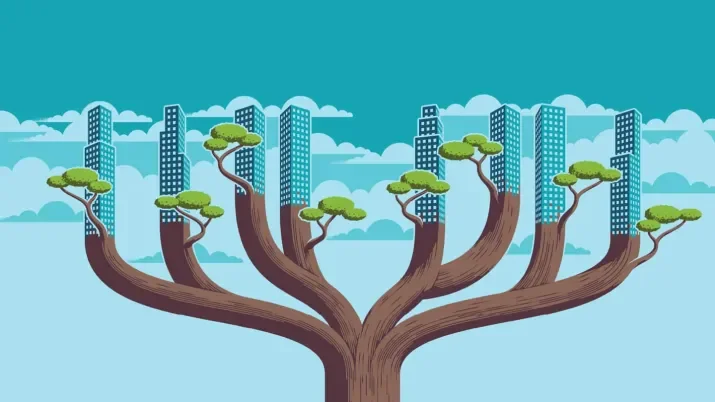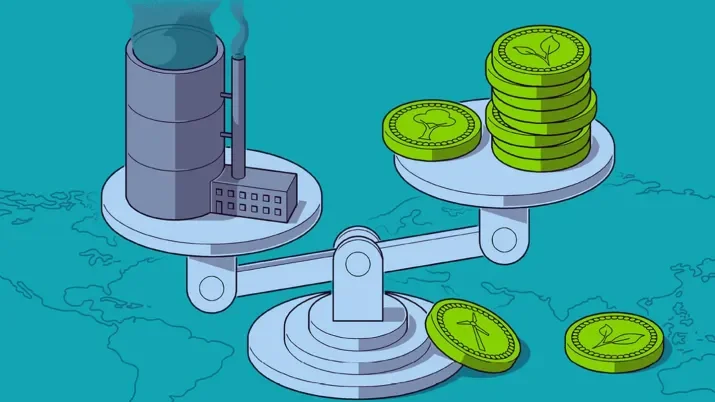Can we put a monetary value on nature?
Asset management
Are we heading for the sixth mass extinction event on planet Earth? Biodiversity loss provides evidence for experts who warn we’re already in the midst of such an event,1 the last of which occurred 66 million years ago and ended the 230-million-year reign of dinosaurs on earth.2 Unlike the past five mass extinction events, the potential – arguably current – sixth is considered to be caused by human agency.3
Right now, in response to one million of the world’s estimated eight million species being threatened with extinction,4 biodiversity, and nature in general, have moved firmly into our collective conscious. From Apple’s 2023 “Mother Nature” advertisement discussing the company’s ESG practices, to the well-planned conference agendas of the United Nations, we’re being asked to talk about nature in a new way. This article provides a bird’s eye view of why investors should care about the semantics, monetization, and regulation of nature.
Remembering nature and rethinking its value
“Man is a part of nature, and his war against nature is inevitably a war against himself.” This seminal quote from conservationist Rachel Carson, remains a defining mantra on the US Environmental Protection Agency website today. Carson’s 1960s book Silent Spring (about the hidden dangers of pesticides), is widely regarded as kick-starting an environmental awareness movement that resulted in the creation of the EPA.5
It is due to advocates such as Carson that the environment has become part of the considerations companies and investors must – and are increasingly regulated – to think about. And now, nature is following suit. The challenges facing nature are so high – and so fundamental to our existence – a collective wake-up call can no longer be ignored. Consider, for example, the following statistics: close to half (USD 44 trillion) of global GDP is dependent, to varying degrees, on nature6; by 2030, the loss of marine fisheries, wild pollinators, and tropical deforestation could reduce global GDP by USD 2.7 trillion annually;7 and, worryingly, only 23 percent of species8 and 16 percent of habitats9 are in good health as measured by EU Nature Directives.
In response, new institutes, associations, and advocacy bodies are arising, pushing for concrete ways to align economic interests with the best interests of nature. One such body is the Taskforce on Nature-related Financial Disclosure (TNFD),10 which in September 2023 – following a two-year period of consultation with different stakeholders and market participants – published a framework to help enable business and finance integrate nature into decision making, and ultimately support a shift in global financial flows away from nature-negative outcomes and toward nature-positive outcomes.
This follows a move from the United Nations in 2021 to establish its System of Environmental-Economic Accounting, referred to as “Ecosystem Accounting,”11 a statistical framework to measure economic prosperity and human well-being, which includes the contributions of nature. As the UN Department of Economic and Social Affairs (DESA) outlined, the aim is to go beyond gross domestic product (GDP) to ensure that natural capital, such as forests, oceans, and other ecosystems, are factored in economic reporting.12
Momentum around nature-related frameworks appears to be quickly gathering speed. In February 2023, the UN published its Global Biodiversity Framework, referring to a new era of action for nature.13 November 2023 saw the European Council and Parliament reach a provisional agreement on new rules to restore and preserve degraded habitats in the EU.14 And in February 2024 the sixth session of the United Nations Environmental Assembly – the world’s highest environmental decision-making body – will meet in Kenya to discuss issues such as the implementation of the Kunming Montreal Global Biodiversity Framework.15
What we can learn from climate
Since Carson’s seminal book was published, the world has made much progress in how we deal with the topic of climate change. The first step here was recognising the issue. And, while we’re currently experiencing a wake-up call around nature and biodiversity, this needs to be followed by a rigorous analysis of how companies are dependent upon and impact nature, both directly and throughout their value chain. Companies must examine how they manage their relationship with nature and deliver on their commitments to mitigate negative impact. Here we can learn – and borrow – a lot from the frameworks that have evolved in the climate space.
However, the challenges for nature include the fact that we cannot offset biodiversity loss. There is no single currency in which the different pressures facing nature can be converted. Global fungibility does not work when it comes to nature services, defined by the IPBES as “nature’s contribution to people” (NCP).16 One example is palm oil, the production of which is responsible for 2.3 percent of global deforestation,17 which leaves a footprint of local habitat and ecosystem destruction. Overcoming this biodiversity loss is not going to be offset by the use of FSC-certified-packaging elsewhere in the palm oil supply chain. Another challenge is that, while we have to piggy-back on our knowledge from the climate movement, we cannot afford the same slow collective awakening and speed of progress that has plagued our response to the climate crisis.
As with climate, the individual actor, be it a company or a household, can exploit and profit from its unpriced externalities, i.e., the negative effects its demand for natural resources is exerting on others. But this is a very narrow and dangerous approach. After all, the real cost of climate, nature and biodiversity is thus far “invisible,” a key reason we’re in this crisis. To be clear, the period we’re currently living in is referred to by the United Nations as a “nature apocalypse,”18 and we cannot afford to be short-sighted while trying to revert this existential era. Investors must take the multi-generational view of investment. It is time to recognize the “prisoner's dilemma”, meaning that communication to achieve collective action is by far the best outcome for all. This is what we mean by seeking to future-proof investing when it comes to the climate and nature space. We must collectively accept that some pressures will only materialise beyond a short-term investment horizon, yet as long-term investors, we need to recognise the need for difficult long-term conversations.
A question of morality or economics, or both?
As a first step, viewing nature as a resource crucial to our economic system can help investors make sense of the issues at stake and their implications for financial markets. Nature is our source: at the most fundamental level, it provides us with what we need to live and function and thrive; at a societal and economic level, assets derived from nature form the foundation of business activities to produce goods and services. The degree of functioning or a potential collapse of ecosystems has a strong impact on the financial markets and the economy. Why then, given its fundamental importance, has nature been historically overlooked by the markets?
Human beings are the most powerful animal and therefore have an inherent stewardship role for the other eight million species on earth. However, human agency is the root cause in discussions of the sixth mass extinction. Our general perception of nature as being abundant, free and an unlimited resource or our challenge in accounting for indirect nature contributions, such as clean air or water in our financial transactions, is part of the problem we have today. Treating natural resources in such manner, and acting as though our usage will not impact others, is acting as if we are outside nature, rather than a part of it, and therefore reliant on its good health.
If we take an economic perspective, a lot can be learnt from how we respond to scarcity. Scarcity is investors’ bread and butter: it drives price and creates value but is also directly linked to geopolitical considerations. Resources only get priced when there is scarcity, and the interplay of demand and supply in defining the scarcity of a resource is key to economic models and investment decisions. Scarcity is not only defined on a global scale: it is essential to consider ‘regional scarcity,’ and the logistics and costs of transporting and shipping resources, which is why trade and geopolitical considerations are so important. In addition, resources like clean water are difficult to transport across long distances, adding another complication.
As discussed above, until recently, within these models, large parts of the natural input have often been considered a free resource as opposed to a scarce one. Often, only certain companies or lobby groups were aware that a resource was becoming scarce as they were extracting it, while the population of a country or a region, particularly when transparency and information about economic and political activities are low, did not realize what was occurring around them, especially pernicious in the case of essential resources like water supply. However, the way – and the urgency with which – we talk about nature is changing. When we take risks with nature, we take risks with the very foundation of our lives and we’re currently witnessing the spread of this realization through our economic system and its financial markets. Nature is being introduced to the language of risk-management frameworks, profit and loss statements, and regulatory requirements. Articles with headlines such as “Nature risk moves up the regulatory agenda”19 are appearing alongside reports from the big consulting agencies encouraging companies to start preparing their responses to the increasing nature-related regulation that’s on the horizon.20 It’s time to start considering nature at every step of the way, including in investing.
Springing into action: a timeline of global reaction to biodiversity loss
1994
- United Nations Framework Convention on Climate Change enters force21
2005
- Kyoto Protocol enters force22
2016
- Paris Agreement enters force23
2022
- Adoption of Kunming-Montreal Global Biodiversity Framework (GBF)24
2023
- COP 28 Dubai (Dec.): COP 28 has a focus on nature (on Dec 9 and 10). The expectation here is that nature-based solutions will be at the negotiation table that deliver both climate and nature co-benefits.
- Task Force on Nature-Related Financial Disclosures (Sept.):25 Release of final 1.0 version of the framework, after two years of work on it with several stakeholders
- International Maritime Organization Members unanimously adopt IMO Greenhouse Gas strategy for net-zero GHG reductions by 2050 (Sept)26
- EU Deforestation-Free Regulation (EUDR) enters force (June)27
- UNESCO’s introduction of the first International Biodiversity Day, annually on May 22 (April)28
- Corporate Sustainability Reporting Directive (CSRD) enters force (Jan.). The first companies will report 2024 results in 202529
2024
- SBTN target guidance on final steps (act and track) in 2024
- COP 16 (Dec.) will take place30
- World Biodiversity Forum (June) is scheduled, with the theme “From Science to Action,” aiming to translate the growing body of research to actions31
2030
- 30% of earth’s land and sea areas to be in conservation per GBF32
- EU to have planted 3 billion new trees33
2050
- According to the European Green Deal, the goal is to halt human induced species extinction by 2050, as well as develop sustainable biodiversity. Europe also aims to be the first climate-neutral continent by 2050.34
Sources
1. https://www.worldwildlife.org/stories/what-is-the-sixth-mass-extinction-and-what-can-we-do-about-it#:~:text=Unlike%20previous%20extinction%20events%20caused,been%20converted%20for%20food%20production.
2. https://www.nationalgeographic.com/science/article/dinosaur-extinction
3. https://www.worldwildlife.org/stories/what-is-the-sixth-mass-extinction-and-what-can-we-do-about-it#:~:text=Unlike%20previous%20extinction%20events%20caused,been%20converted%20for%20food%20production.
4. https://www.unep.org/news-and-stories/story/back-brink-six-species-saved-ecosystem-restoration?gad_source=1&gclid=EAIaIQobChMI8IWJo7TLggMV8oVoCR0FsQV7EAMYASAAEgIuLPD_BwE
5. https://www.epa.gov/history/quotations-about-environment
6. https://www.unepfi.org/industries/banking/beyond-business-as-usual-biodiversity-targets-and-finance/
7. https://www.reuters.com/sustainability/sustainable-finance-reporting/comment-weve-been-mispricing-nature-now-we-must-plug-value-gap-2023-10-11/
8. https://www.wwf.eu/what_we_do/biodiversity/
9. https://www.worldwildlife.org/magazine/issues/summer-2021/articles/a-warning-sign-where-biodiversity-loss-is-happening-around-the-world
10. https://tnfd.global/
11. https://seea.un.org/ecosystem-accounting
12. https://news.un.org/en/story/2021/03/1086102
13. https://www.unepfi.org/themes/ecosystems/the-global-biodiversity-framework-whats-next-for-financial-policy-and-regulation/
14. https://www.consilium.europa.eu/en/press/press-releases/2023/11/09/nature-restoration-council-and-parliament-reach-agreement-on-new-rules-to-restore-and-preserve-degraded-habitats-in-the-eu/
15. https://www.unep.org/resources/kunming-montreal-global-biodiversity-framework
16. https://www.ipbes.net/node/41542
17. https://www.sustainablepalmoilchoice.eu/deforestation-palm-oil/#:~:text=Zooming%20into%20the%20role%20of,deforestation%20(The%20European%20Commission).
18. https://www.unep.org/news-and-stories/statements/bold-action-towards-deal-nature
19. https://www.bankingriskandregulation.com/nature-risk-moves-up-the-regulatory-agenda/
20. https://www.ey.com/en_us/climate-change-sustainability-services/the-nature-related-disclosure-landscape
21. https://unfccc.int/process-and-meetings/what-is-the-united-nations-framework-convention-on-climate-change
22. https://unfccc.int/kyoto_protocol
23. (source: https://unfccc.int/process-and-meetings/the-paris-agreement)
24. https://www.unep.org/resources/kunming-montreal-global-biodiversity-framework?gad_source=1&gclid=EAIaIQobChMIj-iv9tPIggMVyp5oCR2QUQ4pEAAYASAAEgIZUPD_BwE
25. https://tnfd.global/recommendations-of-the-tnfd/
26. https://blogs.worldbank.org/transport/new-climate-deal-shipping-three-decades-zero
27. https://environment.ec.europa.eu/news/green-deal-new-law-fight-global-deforestation-and-forest-degradation-driven-eu-production-and-2023-06-29_en
28. https://www.cbd.int/idb/
29. source: https://finance.ec.europa.eu/capital-markets-union-and-financial-markets/company-reporting-and-auditing/company-reporting/corporate-sustainability-reporting_en
30. https://sdg.iisd.org/events/un-biodiversity-conference-cbd-cop-16/
31. https://worldbiodiversityforum2024.org/session-program/
32. https://www.cbd.int/gbf/targets/
33. source: https://commission.europa.eu/strategy-and-policy/priorities-2019-2024/european-green-deal_en
34. https://commission.europa.eu/strategy-and-policy/priorities-2019-2024/european-green-deal_en



